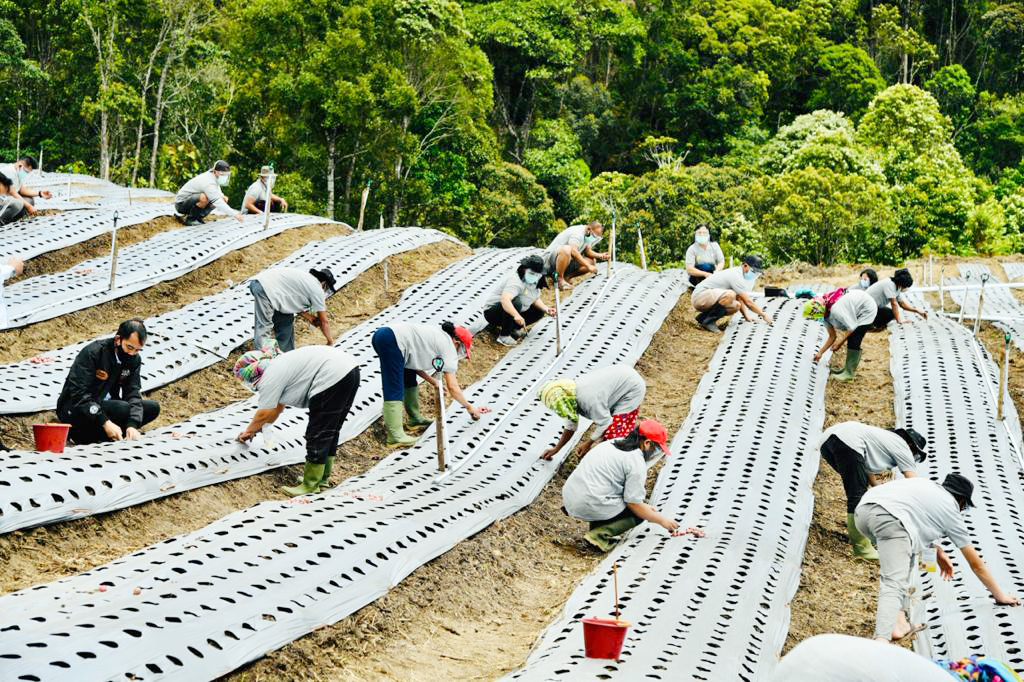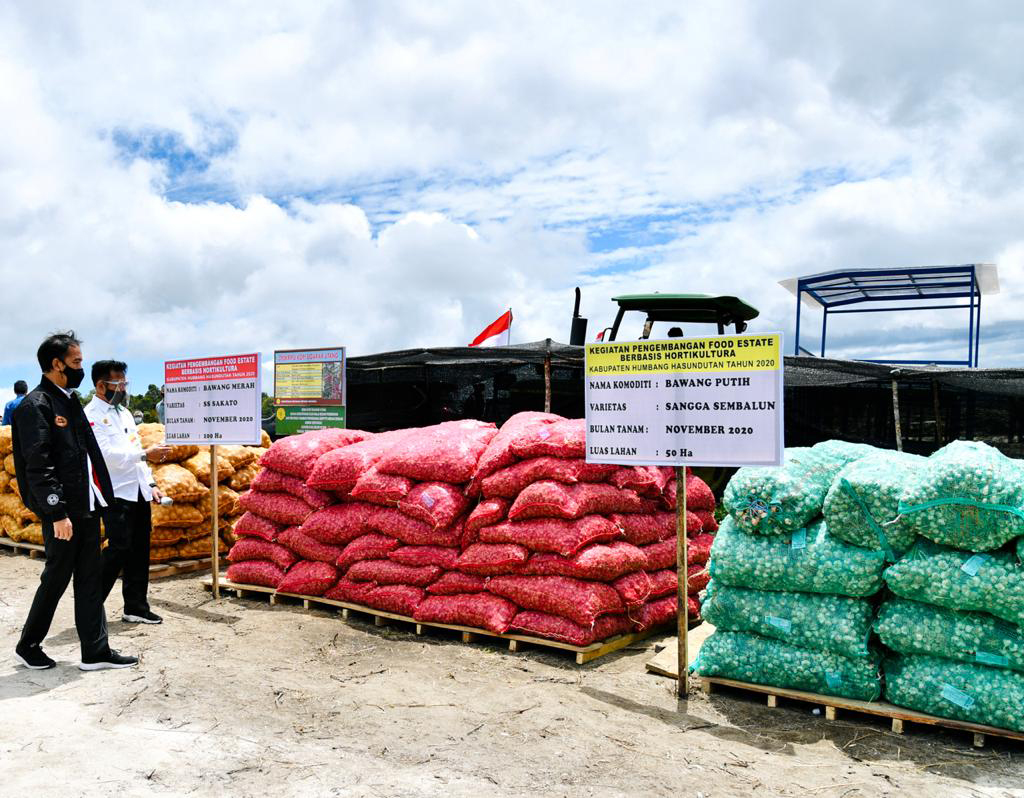
This report was written by Dini Pramita as part of Bagja Hidayat's Rainforest Investigations Network project. To read in bahasa Indonesia, click here.
It was almost midnight on April 13, 2020, when Dosmar Banjarnahor heard Minister of State-Owned Enterprises (SOEs) Erick Thohir announce that because the Covid-19 pandemic was causing Indonesia to face a food crisis, the government planned to establish food estates. “I immediately contacted Pak Luhut,” said Dosmar, who is regent of Humbang Hasundutan, North Sumatra, on September 17, referring to the Coordinating Minister for Maritime Affairs and Investment, Luhut Binsar Pandjaitan.
Through the phone, Luhut Pandjaitan said the main problem with food estates is the lack of available land. Dosmar responded that in his region was a location appropriate to be used as a food estate. “It’s on the Toba Pulp Lestari’s concession, long left idle,” he said. According to Dosmar, the concession area had long been left in disarray by the Toba company after its conflict with the customary community.
Together with Luhut, Dosmar described the food estate concept in an audience with President Joko Widodo at the Bogor Palace, West Java, on June 20, 2020. Two months later, President Jokowi announced the establishment of the food estate program in Humbang Hasundutan. The first planting, comprising shallots and garlic, was conducted on October 22, 2020, at the Ria-Ria village, and then followed with potatoes, despite the fact that a study by an integrated team regarding soil quality was only published in December 2020.
Dosmar submitted a request for land amounting to 31,015 hectares for the food estate program in his region. The request submission is recorded in the National Economic Recovery Food Estate Summary document made by the directorate for establishment and tenure of forest zoning and the directorate-general of forest zoning and environment planning of the ministry of environment and forestry.

In the first stage of the food estate, 215 hectares of land was released, comprising 105 hectares for shallots, 55 hectares for garlic, and 55 hectares for potatoes. Four ministries are involved: the agriculture ministry, environment ministry, the public works and people’s housing ministry, and agrarian affairs and spatial planning. President Jokowi appointed the coordinating ministry for maritime affairs and investment commander of the program.
The first harvest took place on March 23, 2021. Luhut came to Ria-Ria with Agriculture Minister Syahrul Yasin Limpo and Public Works Minister Basuki Hadimuljono. On the same occasion, the three inaugurated the new food estate comprising 785 hectares of land involving seven private companies. “They became the off-takers that absorbed the harvest yields,” said Luhut through Nani Hendiarti, Deputy for Environment and Forestry Management Coordination.
Unlike the ministers, the community did not enthusiastically partake in the first harvest ceremonies. According to farmers, out of 215 hectares only 15 hectares of land managed by the agriculture research and development agency yielded a successful harvest. “The other were failed plots,” said Josua Lumban Batu, a respected member of the Humbang Hasundutan community.
Josua said the establishment of the food estate was conducted with too much of a rush. Officers came to measure land elevation and mapping for irrigation only after the farmers had finished planting. Considering the stages were carried out backwards to establish the food estate, Aslin Simamora, a farmer and another esteemed member of the local community was pessimistic the program would be a success. “Ideally, land preparation and related action to ready it for planting would take six months,” he said. “In this case, after the land was opened up, it was tilled and immediately planted.”
Aslin also assessed sapling quality had declined for being left too long in sheds and some of them had gone bad. “They were also skinny to begin with,” he added. As a result, the harvest target of 20 tons per hectare was not achieved, resulting in only 15 tons.
The quality of the soil was another issue. According to Aslin, the earth in the Toba company plot was known as being sobu-sobu. In local dialect, this means the soil flies like dust in the dry season and is muddy in rainfall. Looking at the land with the naked eye, the soil looks like sand. “It is unsuitable for horticulture,” he said.
Studies carried out by the Research and Development Agriculture Land Resources Center in 2009 revealed the general Humbang Hasundutan area comprised spodosol soil made up of gritty, large specks of sand that was acidic in nature. Its texture and consistency is sandy, hard, and has no cohesion. The land has very low capability for binding soil humus.
Tests by the Bogor Institute of Agriculture (IPB) University, West Java, in 2012 confirmed the same. The open area formerly used for pine reforestation in the Pollung subdistrict has very low containment of humus bind compared to other forest zones. The soil also tended to be more acidic. Mulch spread on its topsoil takes a long time to start binding soil humus.
Agriculture Minister Syahrul Yasin Limpo admitted that the first harvest of the Humbang Hasundutan food estate was not 100 percent because of bad soil quality. “It would be impossible for newly tilled land to be immediately 100 percent good,” he said. Another factor, said the minister, was that culturally, the Humbang community was not yet ready to work a food estate.
Other regional officials made similar statements, blaming the Humbang Hasundutan farming community for not being ready to handle a food estate program. According to Pandiangan, a farmer in the area, Regent Dosmar had said the farmers were not serious in their endeavor. “How come it is us who are at fault? How much more serious should I be?” he asked.
According to Josua Lumban Batu, the community cannot be blamed for being more familiar with growing arabica coffee, sichuan peppers, pine, frankincense, and chilies. “Onions are new for us,” he said. “Culturally, farmers in this area tap frankincense and resin.” For the community, frankincense can bring them Rp400,000-500,000 per kilogram.
Moreover, to the Humbang people, the frankincense tree (Boswellia serrata) is not a mere commodity. They revere the tree for sacrificing its ‘blood’, namely its sap, which allows people to make a living from it. For the Humbang, destruction of the tree is strictly forbidden.
Besides these upstream problems, the North Sumatra food estate also faces problems with absorption of the harvest yields. Despite the fact that the farmers used seedlings distributed by the companies, the companies did not buy back the entire harvest. Potatoes are not usually consumed by households in the area.
Because of no contract between the off-takers and the farmers, the potato harvest yield was not entirely absorbed. Moreover, the companies complied with industry standards for each commodity. Meanwhile, the farmers used their own cash to buy fertilizers and to pay their day laborers. Because the amount of fertilizers distributed to the farmers often was not the amount promised.
Due to these problems, and the underlying issue of conflict regarding the land, the Humbang community held a demonstration when President Jokowi came to inspect the project on October 27, 2020. “We demanded the President make a study first and be transparent to the community regarding establishment of this food estate,” said Josua.
Sudin, Chair of the Farming Commission at the House of Representatives (DPR), also asked the government to conduct a review on the high-cost food estate in Humbang Hasundutan. The agriculture ministry budget for the food estate program in 2020-2021 amounted to Rp268.35 billion.
Sudin said the government has to take particular care in guaranteeing how the program is carried out. “There should be no manipulation of data, and another study should be done on all the problems in the field,” he said.
Another issue that has emerged is the definitive borders of the food estate’s environs. Ria-Ria village Chief, Jon Lumban Gaol, said the sizes of several customary villages shrank after food estate officers came to put in boundary markers. According to the Executive Director of the Community Initiative Research and Development Study Group, Delima Silalahi, who is advocating customary tribes in the food estate matter, several customary lands were included within the project’s boundaries without any prior communication.




